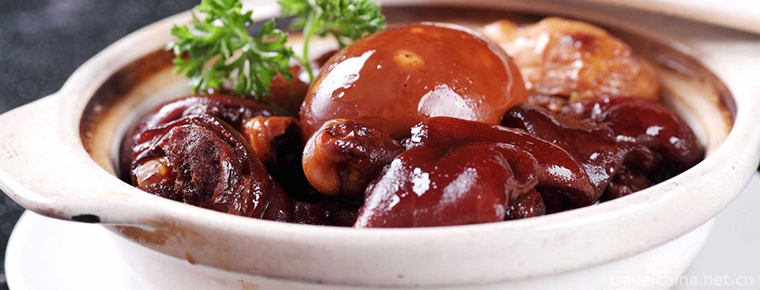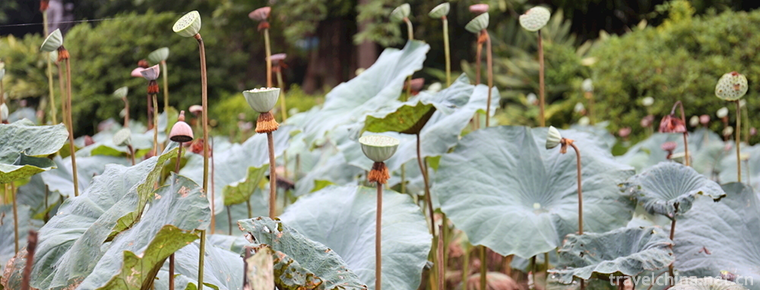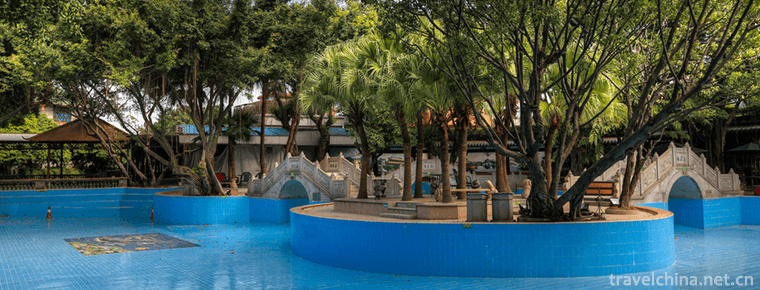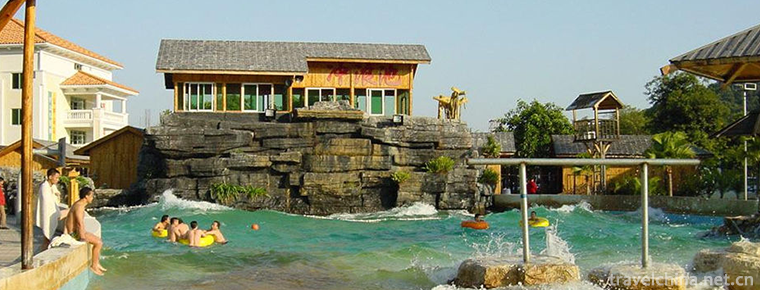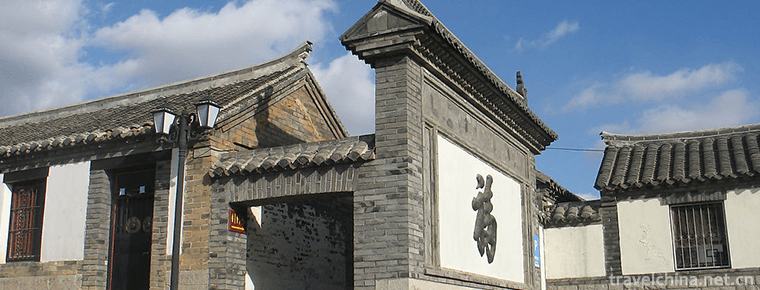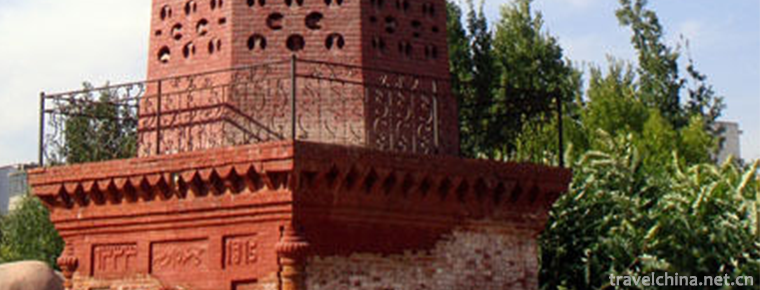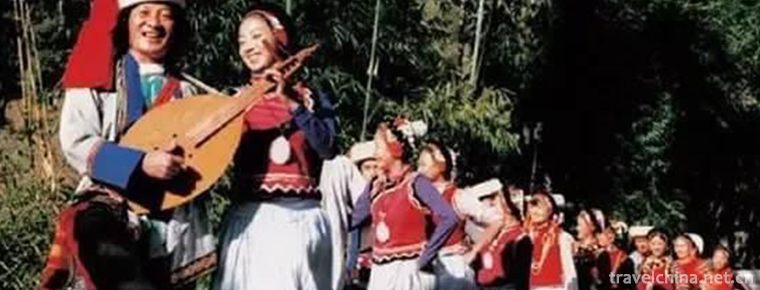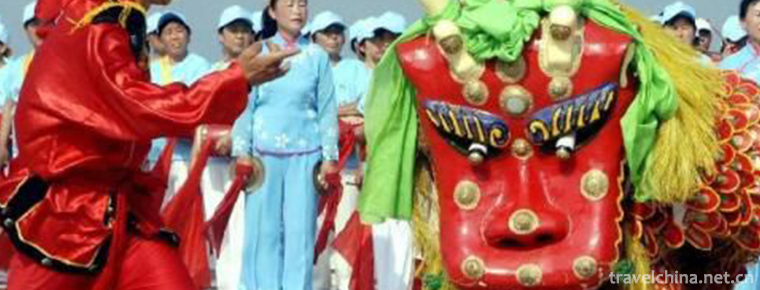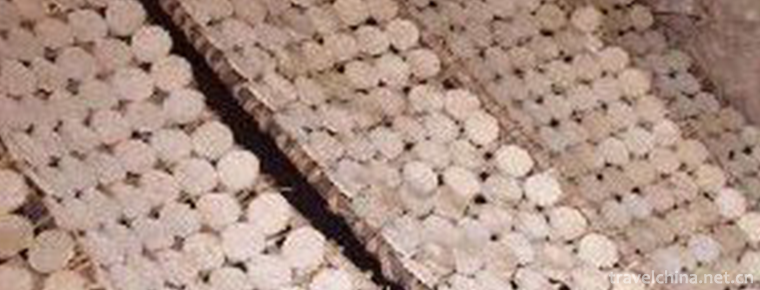String Dance
String Dance
String dance, a traditional dance in Tibet Autonomous Region, is one of the national intangible cultural heritage.
String dance is popular in Sichuan, Yunnan and other Tibetan areas and in Changdu, Tibet. String dance is an indispensable self-musical dance in Tibetan people's life. During festivals, weddings and gatherings, people gather together in a circle, leading dancers singing and dancing, pulling strings (a Tibetan string instrument) accompaniment, the rest of them then gather in the circle, sometimes disperse, hands swing long sleeves, graceful movements.
On May 20, 2006, string dance was approved by the State Council and listed in the first batch of national intangible cultural heritage list, the heritage number: III-19.
historical origin
String dance originated in Batang, and is widely spread in Changdu, Tibet, Kang District of Yunnan, Qinghai and Sichuan provinces, among which Batang string dance is more famous.
Mangkang string dance has a long history. According to textual research, the Mangkang people began to dance string dance in the Tang Dynasty. At that time, the string dance was mainly composed of singing and pulling, and it was a small dance performed in the form of family. With the development of the ancient tea-horse road in Tang Dynasty, the string dance of Jiemangkang injected the vitality of innovation and development. The people of Mangkang continuously absorbed the culture of other regions and nationalities, nourished the string dance and developed the string dance. With life as the theme, everyone created, sang and danced, and processed, constantly enriching the unique national characteristics, regional characteristics and characteristics. With its artistic characteristics, string dance has become a popular cultural and entertainment activity. It has become a jewel of culture and art in the long history of Tibetan people and is known as the "charm" of the ancient tea-horse road.
Contemporary Mangkang string dance has become an important way of entertainment for the Tibetan people. Every festival in the sixteen townships (towns) of Mangkang, rich and colorful literary and artistic activities are carried out, which enrich and activate the spiritual and cultural life of the masses, improve the cultural quality of the masses and enhance their cultural quality to the motherland. And the love of home. Mangkang string dance has a long history, ancient and magical, unique form, strong national temperament, rich plateau characteristics, more schools, complete performance system, and its singing and dancing tradition is precious.
On May 20, 2006, "String Dance" was declared by Tibet Autonomous Region and listed in the first batch of national intangible cultural heritage list,
Dance features
Performing Form
When performing, men pull strings and women dance color sleeves. With the change of strings rhythm, singing and dancing gestures vary. Most of the lyrics of String Zi are greeting, meeting, praise, affection, farewell and wishes. There are many tunes, rich lyrics and changeable dance steps. When dancing, men and women dance in half circles, sometimes gather in circles, sometimes evacuate, and sing and dance; men dance mainly in boots, stamp feet, showing the beauty of bold and rough; women highlight the beauty of long sleeves soft and stretching.
The content of string dance generally includes three aspects: first, welcome and thank each other, praise each other, greeting and meeting dance; second, praise and dance with respect for elders and love for home; third, express love and pure and sincere friendship between young men and women, including meeting and meeting. Love singing and dancing about love, parting and wishing. The strings are lively and enthusiastic, and the dances are easy to express feelings.
String dancing is not restricted. No matter how many people, the size of the venue, or on or off the stage, string dancing can be performed. When dancing string dancing, it is usually around the bonfire circle, not limited by the number of people, venues and so on. Many people can also circle, men and women can be separated in half. Men pull strings and stand in front of each other, leading the crowd to brush their sleeves and dance, sometimes gather, sometimes scatter, sometimes walk around, while singing and dancing, men and women singing together, one after another. The rhythm of dance is based on the music rhythm of men's strings. Generally, it begins with melodious and gentle, expresses itself in fluency and joy, and ends with vigorous ascension.
Performing props
String dance is based on strings as instruments. With the music melody, men and women gather and dance. Tibetan is called "Tibetan Harmony Qiang", "Tibetan" means Tibetan, "harmony" means singing and dancing, and "Qiang" means dancing. String Zi is called "Bai Yang", which is an instrument invented by local people themselves. It is shorter and thicker than Erhu in other areas. It is called "Huqin" in historical books.
Dance movements
String dancing is characterized by imitating some kind and auspicious animal gestures, such as Peacock Absorbing Water, Rabbit Running Merrily and so on. The dance steps are round, stretching, melodious and fluent. The movements of "dragging", "turning around at a point", "swinging sleeves" and "trembling at the waist" in string dancing, especially the long sleeves flying, are very distinctive.
Generally speaking, the shape of string dancers requires upper body movements like lions, waist movements like enchantment, dexterous limbs and joints, loose tendons, soft body posture, proud facial expression, fluttering knees, flexible foot tips and strong shadows. 。 It is not difficult to see the basic aesthetic ideas of Tibetan string dance from the basic requirements of string dance on various parts of the human body. The basic characteristics of dance aesthetics are body beauty, rhythm beauty and movement harmony beauty.
String dance emphasizes the coordination and unified use of feet, knees, chest, hands, shoulders, head and eyes. In string dance, the upper body movements of male dancers are very exquisite. Whether they hold props or not, their upper body movements are as magnificent as a lion. They are full of the heroic and bold temperament of Plateau people, giving people the belief to overcome all difficulties and obstacles. The upper body movements of female dances require implicit elegance and give people a gentle and graceful feeling. Among them, the waist movements in string dance are very rich. Whether it is the "heap harmony" with the main foot points or the gentle swing of the "harmony" waist with the most dynamic lines, it gives people a full display of the human body's line beauty in the quasi-motion and non-motion. All kinds of turning over, side waist, lower back waist and other movements have achieved the ultimate waist. The "enchanting" waist movement is a prominent aesthetic feature of Tibetan dance.
distinguishing features of music
String dance, beautiful dance posture, both rigid and soft, fast and smooth strings, clear and bright rhythm. Most of its tunes are loud and bright, rough and bold, rich and colorful. The music structure is generally composed of two phrases and four phrases. One tune, many lyrics, repeated singing. The song actually has the title of a song, which is the same as that of a Chinese word. First for the carol, friendship song, then for the song, men and women compete high and low, to win by skill. If the song lasts for a long time, or there is a conflict between sarcasm and attack each other, the leader will come on to lead the singing to explain the song, both sides will be happy and disband.
The lyrics of string dance are improvised, with wonderful contents, except that some of the ancient songs have fixed lyrics. The Lyric structure is mostly in the form of "consortium" with six words and three tongues, and also in the form of "Lu style" with seven words and four tongues and eight words (or nine words and ten words). Lyrics creation and comparison, Xing, Fu and other methods, vivid metaphor, profound implication, expressing emotions implicitly beautiful, narrative simple and natural. Nowadays, many artists have given new life to the traditional string dance and created many string dances in praise of the new life. String dance has the characteristics of gentleness, elegance and interesting, as well as bold, free and unconstrained style.
The lyrics of string dance express a wide range of contents, such as singing about working life, describing natural scenery, and pouring out love. The string dance not only gives people the enjoyment of music, but also is the essence of folk language. Its folk free poems, which are full of gallop, test folk games of intelligence, give people spiritual food, rich life breath and profound educational significance.
Major branches
Mangkang String Dance has many schools because of its differences in natural environment, history and culture, but its general characteristics are simple, rough, vigorous, robust and plain. It is integrated with the local natural scenery: blue sky and white clouds, snow mountain grassland, Canyon rapids, dangerous beach and horse-running, and other unique magnificent scenery of the eastern Tibetan plateau. It has become Mangkang's unique humanistic landscape.
Mangkang String Dance
Mangkang string dancing is full of vigor, wild and fluent. It has such movements as dragging, turning around, shaking sleeves, and trembling steps on the waist. Long sleeves are the most characteristic. Dancers emit "tremors" as the strings sway, and dance movements produce "tremor" accordingly. These movements mostly simulate some kind and auspicious animal gestures as body characteristics, such as "peacocks absorb water" and "rabbits run merrily".
Mangkang string dance can be divided into salt well string dance, Xuzhong string dance, Sodoxi string dance, Qudeng string dance and so on. String dance in different places has different characteristics. Its general characteristics are simple, rough, vigorous, robust and simple.
Salt well string dance is dignified and solemn. It shows its own characteristics in dignity and solemnity. It has the momentum of Lancang River, the charm of mountains and rivers, and the magnificent lyrics. It gives people a feeling of ambition and upward struggle. Quzika's tri-string dance has the unique style of Lancang Jiangxi. It has the charm of "Tea-Horse Ancient Road". Its magnificent tone matches the rough dance posture. It is primitive, simple and elegant.
Xu Zhongzi's chord dance is elegant, long sleeve stretches, melodious singing, beautiful melody, foot-dragging, turn handsome, smooth movement. Music and dance steps are closely integrated, rich lyrics, melodious songs, giving people a sense of authenticity.
Sodosi string dance is good at imitating, difficult and easy to stretch, giving a sense of unrestrained and lively. The long sleeve flutters, the movement range is large, the music is comfortable and happy, the footsteps are relaxed, the body stretches, highlighting the characteristics of long sleeve dance. Rabbit Running is the representative work of Sodoxi String Dance, which expresses the people's desire for freedom, love, love for life and praise of their hometown.
Qudeng string dance is free and open, relaxed and cheerful, with distinct rhythm and warm mood. It shows that Qudeng people love nature, yearn for freedom and peace, and pursue a better life.
Batang String Dance
Batang string is a beautiful and Lyric Tibetan dance with the characteristics of "long sleeve and good dance". During the performance, several men with a string instrument "Biwang" (Huqin) played the lead dance in front of the team. The rest of the dancers sang and danced with them. In Batang, men and women gather to sing and dance on festivals. Generally speaking, the male gymnastics "Baiwang" (Niujiaohu) stands in the front row, pulls up the Huqin to lead the crowd to brush their sleeves and dance, sometimes gathers, sometimes scatters, sometimes walks around and dances, sings and dances, sings the lyrics as a "harmonious" folk song, or improvises the male and female singers to express their inner interests.
Yushu Yiwu
Yushuiyi dance is a representative form of folk dance in Tibetan dance, which is deeply loved by the Tibetan people in Yushu. Yushuyi Dance is a compulsory dance for Folk Dance Majors in professional dance schools all over the country. Yushu dances with elegant and unrestrained gestures, big movements, strong and powerful steps, fast and smooth rhythm, rough and bold style. The basic movements of female dancers are a little swing, double twist step, cushion step, double hand wrapping, single twist step, left and right legs, forward step, rolling, forward and backward rutting. The male dancers hold strings and sing while pulling, and the footsteps are similar to those of female dancers. Among them, dance sleeves are the basic characteristics of Yushu Yiwu dance, and three steps and one bend are the basic movements in the dance steps. The lyrics of Yushu Yiwu mostly adopt traditional content, mainly to praise the scenery of his hometown, sing about his working life and pray for good luck and happiness.
Inheritance and Protection
Inheritance value
Tibet is known as "the sea of singing and dancing". The Tibetan people are good at singing and dancing. They are known as "the people who can speak, sing and dance when they walk". No matter men, women, old or young, they can dance. Mangkang's string dance is also a wonderful flower in the flourishing cluster of Tibetan national culture. Its simple, elegant, free-flowing, melodious and cheerful characteristics make people endless to see. And Mangkang string dance reflects their own life, expresses their thoughts and feelings, shows unique aesthetic and artistic taste, is one of the precious cultural heritage inherited and developed in Tibetan culture.
Batang string is the crystallization of Batang people's wisdom. Batang string dance is rich in national culture and reflects strong national customs. Its academic value and artistic value are very high. Batang string with thousands of tracks has become the greatest treasure of Tibetan folk music. It is the "living fossil" of the best preserved Tibetan music. Its music and lyrics have penetrated into other Tibetan literature and art. Protecting Batang string is very important for protecting Tibetan singing and dancing art and studying Tibetan culture. Significant significance.
Current situation of inheritance
Contemporary Mangkang string dance has become an important way of entertainment for the Tibetan people. Every festival in the sixteen townships (towns) of Mangkang, rich and colorful literary and artistic activities are carried out, which enrich and activate the spiritual and cultural life of the masses, improve the cultural quality of the masses and enhance their cultural quality to the motherland. And the love of home. Mangkang string dance has a long history, ancient and magical, unique form, strong national temperament, rich plateau characteristics, more schools, complete performance system, and its singing and dancing tradition is precious.
Heritage figures
Tsiren Wangdui, male, Tibetan, is the representative successor of the second batch of national intangible cultural heritage projects. On December 28, 2017, it was selected as the recommendation list of the fifth batch of national intangible cultural heritage representative projects and declared by Tibet Autonomous Region.
protective measures
In the second half of 2011, Changdu Experimental Primary School specially offered string dance course in the second classroom teaching. Since the second half of 2012, Changdu Experimental Primary School has adapted string dance into classroom exercises so that all students can participate in it. By the second half of 2012, there were 1986 students in the school, all of whom could participate in the dance.
In 2018, around the protection of non-heritage sites, Mangkang County strived for 1.15 million yuan of special subsidies from the central government and 100,000 yuan of special protection funds at the municipal level, and relying on the "Cultural Heritage Day" vigorously carried out a series of distinctive non-heritage exhibitions, exhibitions and exhibitions, in which string dance was effectively inherited and developed.
social influence
Important activities
In June 2007, in Lukang Park, Zongjiao, Lhasa, a traditional Tibetan folk culture and art exhibition with the theme of "Protecting Cultural Heritage and Building a Harmonious Society" was held, in which string dance was displayed.
In January 2008, the string dance was displayed in the special performance of the "two sessions".
In September 2010, in Tibet Auto Industry and Trade, a literary and artistic evening party was held to welcome the National Day "Love me China, love me Tibet", in which string dance was displayed.
Honorary recognition
In May 2000, the Ministry of Culture officially named Batang County as the "Town of Chinese Folk Art".
In August 2008, string dance won the first prize for performance and creation in the 9th Peach and plum Cup Dance Competition.


-
Jiang Cudan Canton style pig leg
Except for those with internal fever, dry stool and weak spleen and stomach function, breast enlargement products can be used as a warm-up tonic in winter..
Views: 234 Time 2018-11-02 -
Three Water Lotus World
Foshan Sanshui lotus world is the largest lotus scenic spot in the world with the richest variety resources. It integrates architecture, sculpture, Dutch, mobile games, hotels and catering.
Views: 165 Time 2018-12-18 -
Ertan National Forest Park
Ertan National Forest Park is located in Yanbian County and Miyi County, the northern suburb of Panzhihua City, Sichuan Province, with a total area of 732.4 square kilometers .
Views: 137 Time 2018-12-22 -
Bao Mo yuan
Baomo Garden is located in Zini Village, Shawan Town, Panyu District, Guangzhou City, Guangdong Province. It was built in the late Qing Dynasty and covers an area of five mu.
Views: 156 Time 2019-01-02 -
Huizhou Seaside Hot Spring Resort
Huizhou Coastal Hot Spring is a large-scale comprehensive resort built according to the national standard of "AAAAAA" scenic spots and five-star hotels. It integrates tourism and vacation.
Views: 207 Time 2019-01-19 -
Qixia Mous Manor
Mou's Manor, also known as Mou Erhei Manor, is located in Ducun, an ancient town in the north of Qixia City (the northern head of the original Xiaguang Third Road)..
Views: 151 Time 2019-02-07 -
Construction Skills of Russian Nationality Residences
Historically, Tacheng once had the reputation of "Oriental Moscow", which is by no means a historical accident. It has a close relationship with the border trade in the past 150 years.
Views: 345 Time 2019-04-28 -
Nu Dabian Dance
"Dabian Dance" is one of the representative dances of the Nu nationality, which is spread in the Nujiang Lisu Autonomous Prefecture Fugong County Nu villages. Dabian dance is characterized b.
Views: 126 Time 2019-06-08 -
kylin dance
Kirin dance, also known as "Wu" Kirin, is a court dance performance of the Ming Dynasty in China. It was spread among the people when the Nanming Dynasty perished. When dancing, .
Views: 98 Time 2019-06-10 -
Soil alkali firing technology
On June 7, 2008, the soil-alkali firing system was approved by the State Council and listed in the second batch of national intangible cultural heritage list..
Views: 388 Time 2019-06-23 -
Yibin Jiuzhou tower
Jiuzhou tower was built in the third year of Daguan in Northern Song Dynasty, that is, in 1109 ad, located in Yibin, Sichuan Province. The foot of the tower is 7.35 meters long from north to south.
Views: 319 Time 2020-10-16 -
Guangan Railway
Guang'an has five passenger railway stations (Guang'an station, Guang'an south station, Yuechi station, Huaying station and wusheng station). Among them, Guang'an station is an important material and passenger distribution center in eastern Sic.
Views: 199 Time 2020-12-19
